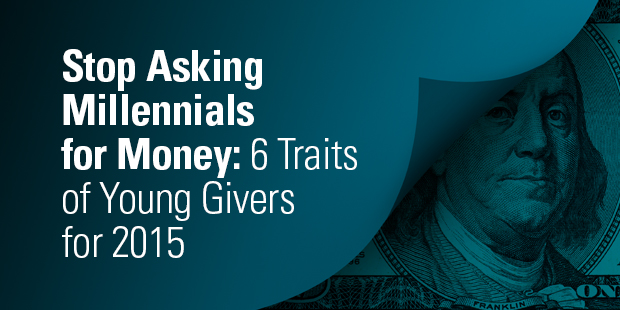
Stop Asking Millennials for Money
Drawing on the findings from research into giving by millennials here and here, I’ve compiled six traits of young givers that charities and non-profits would be wise to keep in mind as they look to engage with the $200b spending power of the Millennial generation:
1. We like to invest in ideas that actually make a difference
Photos of starving children don’t stir us to donate, rather they stir us to care about fixing the root of the problem. We want to donate toward something that will help prevent poverty, hunger and trafficking altogether. Have you noticed the term “social enterprise” is on the rise? As the discussion on development and market-based solutions is advancing, so is our interest in innovative ideas to donate to. Or rather invest in.
2. Our buying looks like our giving
Many creatives and entrepreneurs have recognized the opportunity to blend social impact with business. This competition has driven an increase in the quality of socially-benefitting goods, and they’re no longer just unworn beaded bracelets from Africa. Many of them are really cool and mainstream now. Check out Boll & Branch’s comfy fair trade and organic throw blankets, or these leather bags and jewelry from fashionABLE.
3. The experience is everything
The cost of traditional entertainment is through the roof these days. Since we go to the movies less these days (the cost of that alone rivals a nice meal out), we instead hope our donation experience will give us some level of satisfaction. Invitations to attend meet and greats, events, volunteer functions, and best yet, a seat at the table for decision-making, all of these engage the Millennial’s desire to create a memorable experience.
4. Smartphones are good for more than just social media
For years, charities have pushed social media campaigns on us, inviting us to share and tag and hashtag and what not. But we’re doing more on our smartphone than just social media. Propelled into the mainstream by the introduction of Apple Pay, more of us are not carrying around cash, and we’re definitely not carrying around checkbooks. We want the ease of payment through our phones, but only if it can be as simple and streamlined as a song download. At eChurchGiving we’ve found that 85 percent of users abandon mobile giving attempts if the transaction takes longer than 30 seconds. Average experiences for online giving can take up to three or more minutes. That’s a major lost opportunity for most charities and churches.
5. Embrace the Thrifty
As mentioned above, many Millennials are caught in this tension of feeling generous, wanting to be more generous, but being held back by thrifty habits. However, position a campaign in a way that taps into both thriftiness and generosity, and Millennials will jump on board. An example, Kickstarter’s Founder just started Dollar a Day, where you commit to donate a dollar each day, and they send you an email each morning with the story of the non-profit your dollar went to. That’s one thrifty way of donating $365.
6. It’s cool to care
I grew up in an era where it was cool not to care, about anything. Sagging pants, oversized hoodies, poor posture, and one word answers, these were the character traits of many popular figures. Thankfully, that’s not the case anymore. The rise of technology has made intellect a valued commodity. Combine that with the shared desire to leave the world a better place, it’s all of a sudden really really cool to care. And not just to care, but to do something about it.
How are you engaging the Millennials in your church in generosity?

Tags: Derek Gillette, Generosity, Millennial generosity, Millennial giving, PushPay, eGiving











